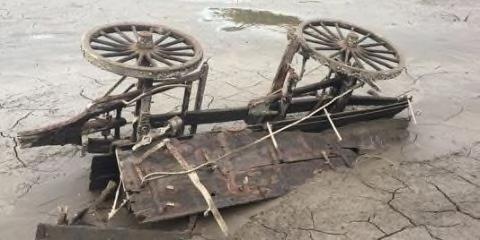In 2015, a historic drought gripped America’s West Coast, leaving reservoirs parched and landscapes transformed. But in Marion County, Oregon, the receding waters of Detroit Lake revealed something extraordinary—an entire forgotten town, hidden beneath the surface for over six decades.
As the lake hit its lowest level in nearly half a century, the skeletal remains of Old Detroit, a once-thriving railroad town, emerged from the depths. Alongside crumbling foundations and old roads, a stunning artifact surfaced—a pristine 19th-century wagon, preserved as if time had stood still.
This is the story of a town swallowed by progress, a relic lost to history, and the eerie beauty of a drought that brought the past back to life.
The Drought That Uncovered History
For four long years, the American West suffered through one of its worst droughts in modern history. Rivers shrank, reservoirs dwindled, and communities braced for water shortages. In Oregon, Detroit Lake, a key water source for nearby cities like Salem, reached a shocking 1,426 feet—its lowest level since record-keeping began in 1953.
But as the waters retreated, something unexpected appeared.
A Sheriff’s Chance Discovery
In October 2015, Marion County Sheriff’s Deputy Dave Zahn was patrolling the dried-up lakebed when he spotted something unusual—a wooden wagon, partially buried in the mud.
What made this discovery remarkable?
- The wagon was over 140 years old, dating back to 1875.
- It was incredibly well-preserved, thanks to the low-oxygen environment at the lake’s bottom.
- A plaque identified it as the work of the Milburn Wagon Company, once the world’s largest wagon manufacturer.
Cara Kelly, a U.S. Forest Service archaeologist, noted that the wagon had suffered more damage in the few weeks it was exposed to air than in the 60+ years it spent underwater.
This was just the beginning. As the lake continued to shrink, more remnants of Old Detroit began to surface—foundations, roads, and echoes of a lost era.
The Rise and Fall of Old Detroit
A Railroad Town Born from Ambition
Founded in 1880, Old Detroit began as a railroad camp for workers constructing the Oregon Pacific Railroad. The brainchild of businessman Thomas Egenton Hogg, the railroad was meant to connect Oregon to the eastern United States.
Hogg’s vision was grand:
- The tracks would follow the North Santiam River, cutting through the Cascade Mountains.
- The line would eventually link to the transcontinental railroad, opening up trade routes.
But like many grand plans, it fell short.
A Dream Derailed
Hogg ran out of money before the railroad could cross the Cascades. Instead, he pivoted to steamships, connecting his existing tracks to San Francisco. By the time the Oregon Pacific Railroad stalled at Idanha, just 15 miles short of the mountains, Old Detroit had already become a key stop for loggers transporting timber eastward.
At its peak, the town boasted:
- Cafés, a cinema, and a church
- A hardware store and school
- A bustling railroad turntable (used to redirect locomotives)
Yet, despite its prosperity, Old Detroit’s fate was sealed—not by economic failure, but by nature itself.
The River That Doomed a Town
Floods and the Fight for Control
The North Santiam River, fed by Cascade Mountain snowmelt, was both a lifeline and a curse. While it powered industry and agriculture, it also brought devastating floods to the Willamette Valley.
- Salem and other towns faced millions in damages from seasonal flooding.
- Farmers struggled as torrential waters destroyed crops and homes.
In 1938, Congress passed the Flood Control Act, authorizing dams to tame the rivers. Engineers proposed two dams—one of them the massive Detroit Dam.
The Dam That Buried a Town
Completed in 1953, the Detroit Dam was an engineering marvel:
- 1,580 feet long, 360 feet tall
- Capacity to hold 455,000 acre-feet of water
- Fifth-largest dam of its kind in the U.S.
But there was a catch: the reservoir would flood 3,580 acres, including Old Detroit.
The Great Relocation
Rather than let their town vanish forever, residents took drastic action:
- Dismantled homes piece by piece
- Dragged them uphill by sled to a new site
- Rebuilt Detroit just above the waterline
Some of these relocated buildings still stand today, silent witnesses to a town’s stubborn survival.
Ghosts of the Lake: What Remains of Old Detroit?
Every winter, when dam operators release water to prepare for spring snowmelt, parts of Old Detroit briefly reappear. But in 2015, the drought exposed more than ever before.
The Mysterious Wagon
- Likely used in railroad construction before being abandoned.
- Built by Milburn Wagon Co. (Toledo, Ohio), the world’s leading wagon maker in the 1800s.
- Preserved so well that its wooden panels and metal fittings were intact.
Other Relics
- Foundations of homes and businesses
- Old roadbeds leading to nowhere
- Railroad remnants, including ties and spikes
Will Old Detroit Resurface Again?
Water levels haven’t been this low since 1969, and it may be decades before they drop again. Archaeologists hope the artifacts remain submerged—protected from looters and decay.
Conclusion: A Town Frozen in Time
Old Detroit’s story is one of ambition, survival, and surrender. A railroad dream that failed, a town that refused to die, and a lake that both erased and preserved history.
For now, the wagon and the ruins have returned to the depths. But when the next great drought comes, who knows what other secrets Detroit Lake might reveal?


